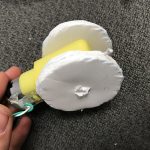The idea was to create a bat that would respond differently depending on where it was “pet”. Since no linear softpots were available, this idea evolved into its current state using the rotary soft pot.

Much of the difficulty was getting the readings to be consistent, testing different mapping values (there’s no indication of how to map output values to pot inputs, whether it should be inches, radians, degrees around the rotary pot etc.) and figuring out why the pot wasn’t reading half the time. The pot does read in degrees it seems, and is better for touch detection in a certain area, rather than producing a spectrum of tones by running your finger along the circle.
Note: Despite what some websites recommend, do NOT connect softpot directly to power and ground. It will burn the pot.
https://drive.google.com/drive/folders/0B6vucT1cFrpgeXJFWDhzSDA1MEk?usp=sharing
All files should now just be public.













